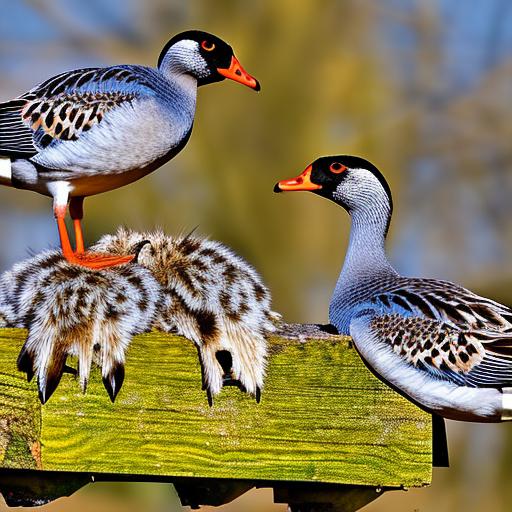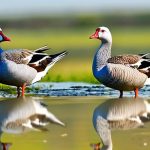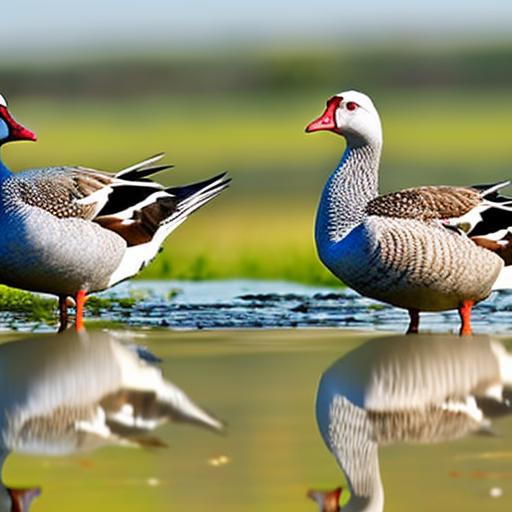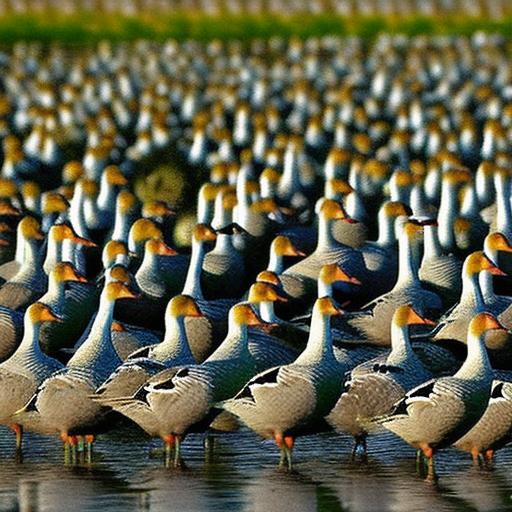Geese are known for their elaborate courtship rituals, which play a crucial role in the formation of breeding pairs. These rituals typically begin in the early spring, when geese start to pair off for the breeding season. The courtship process involves a series of displays and behaviors that help the geese establish and strengthen their bond. This can include elaborate dances, vocalizations, and displays of affection. For example, male geese may perform a “triumph ceremony” where they stretch their necks and flap their wings to impress potential mates. Once a pair has formed, they will often engage in mutual preening and other bonding behaviors to solidify their relationship. These courtship rituals are essential for ensuring that the breeding pair is committed to each other and ready to embark on the next stages of the breeding process.
In addition to these displays of affection, geese also engage in territorial behaviors to establish and defend their nesting sites. This can involve aggressive displays towards other geese or animals that come too close to their chosen nesting area. These territorial behaviors are an important part of the courtship process, as they help to ensure that the breeding pair has a safe and secure location to raise their offspring. Overall, the courtship rituals of geese breeding pairs are a fascinating and essential part of the breeding process, helping to establish strong bonds between mates and secure a suitable nesting site for the upcoming breeding season.
Finding the Perfect Nesting Site
Once a breeding pair has formed, the next step in the breeding process is finding the perfect nesting site. Geese are known for their strong nesting instincts, and they will go to great lengths to find a suitable location to build their nest. This can involve extensive searching and exploration of potential nesting sites, as well as territorial behaviors to defend their chosen location. Geese typically prefer nesting near water, such as lakes, ponds, or rivers, as this provides easy access to food and protection from predators. They may also choose nesting sites in open fields or grassy areas, where they can keep an eye out for potential threats while incubating their eggs.
In addition to the physical characteristics of the nesting site, geese also consider other factors when choosing a location for their nest. They prefer areas with good visibility, so they can keep an eye out for predators while incubating their eggs. They also look for sites with ample nesting materials, such as grasses, reeds, or other vegetation that can be used to build a sturdy nest. Once a suitable location has been found, the breeding pair will begin the process of building their nest, using a combination of materials they find in the surrounding environment. Overall, finding the perfect nesting site is a crucial step in the breeding process for geese, as it sets the stage for the upcoming stages of egg-laying and incubation.
Building the Nest: A Team Effort
Once a suitable nesting site has been found, the breeding pair will begin the process of building their nest. This is typically a team effort, with both the male and female geese contributing to the construction of the nest. Geese are known for their meticulous nest-building skills, using a combination of materials such as grasses, reeds, and other vegetation to create a sturdy and secure structure for their eggs. The female goose will typically take the lead in building the nest, while the male goose will gather materials and bring them back to the nesting site. Together, they work tirelessly to create a comfortable and safe environment for their upcoming offspring.
The nest-building process can take several days to complete, as the geese carefully arrange and shape the materials to form a bowl-shaped structure that will cradle their eggs. They may also line the nest with down feathers or other soft materials to provide insulation and protection for the eggs. Once the nest is complete, the breeding pair will continue to maintain and reinforce it throughout the incubation period, ensuring that it remains secure and comfortable for their developing offspring. Overall, building the nest is a crucial team effort for geese breeding pairs, setting the stage for the next stage of the breeding process.
The Egg-laying Process
After the nest has been built, the female goose will begin the process of laying her eggs. Geese typically lay a clutch of 4-6 eggs, with one egg being laid every 1-2 days until the clutch is complete. The female goose will carefully arrange the eggs in the nest, using her body heat to keep them warm and protected while she continues to lay additional eggs. Once the clutch is complete, both parents will take turns incubating the eggs, ensuring that they remain at a consistent temperature and are protected from predators.
The egg-laying process is a crucial stage in the breeding cycle for geese, as it marks the beginning of the incubation period and the development of their offspring. Geese are known for their strong maternal instincts, and they will go to great lengths to ensure that their eggs are well cared for during this time. The female goose will remain dedicated to her nest, only leaving briefly to feed or bathe before returning to continue incubating her eggs. The male goose will also take on a more active role in protecting and defending the nest during this time, ensuring that it remains safe from potential threats. Overall, the egg-laying process is a pivotal stage in the breeding cycle for geese, marking the beginning of their journey towards parenthood.
Incubating the Eggs: A Shared Responsibility
Once the clutch is complete, both parents will take on the responsibility of incubating the eggs. This is typically a shared effort, with both the male and female goose taking turns sitting on the nest to keep the eggs warm and protected. Geese are known for their strong parental instincts, and they will go to great lengths to ensure that their eggs are well cared for during this time. They will also engage in aggressive behaviors towards potential threats or predators that come too close to their nest, ensuring that their offspring remain safe and secure.
The incubation period typically lasts around 25-30 days, during which time both parents will remain dedicated to their nest, only leaving briefly to feed or bathe before returning to continue incubating their eggs. This shared responsibility helps to ensure that the eggs remain at a consistent temperature and are well protected from potential threats. Once the eggs begin to hatch, both parents will continue to work together to care for and protect their offspring, marking the beginning of a new chapter in their journey towards parenthood. Overall, incubating the eggs is a shared responsibility for geese breeding pairs, highlighting their strong bond and commitment to raising their offspring.
Protecting the Nest and Offspring
Throughout the incubation period and beyond, both parents play a crucial role in protecting their nest and offspring from potential threats. Geese are known for their aggressive behaviors towards predators or other animals that come too close to their nesting site. They will engage in loud vocalizations and aggressive displays to ward off potential threats, ensuring that their offspring remain safe and secure. This protective behavior continues even after the eggs have hatched, as both parents work together to care for and defend their goslings.
In addition to protecting their offspring from predators, geese also face other challenges during this time, such as adverse weather conditions or human disturbances. Both parents will work together to ensure that their offspring remain safe and well cared for during these challenging times. They may also lead their goslings on long journeys to find suitable feeding areas or safe resting spots, demonstrating their strong commitment to providing for their offspring’s needs. Overall, protecting the nest and offspring is a crucial responsibility for geese breeding pairs, highlighting their dedication and determination to ensure that their offspring have the best possible start in life.
Teaching the Goslings: The Role of Both Parents
Once the goslings have hatched, both parents play an important role in teaching them essential life skills. This can include leading them on feeding expeditions to find suitable food sources or teaching them how to swim and navigate through waterways. Both parents work together to ensure that their goslings have all the tools they need to survive and thrive in their environment. This can involve leading by example or providing gentle guidance as they explore their surroundings.
In addition to teaching essential life skills, both parents also play a crucial role in providing emotional support and protection for their goslings. They will continue to engage in protective behaviors towards potential threats or predators that come too close to their offspring, ensuring that they remain safe and secure at all times. Both parents also provide comfort and reassurance for their goslings during times of stress or uncertainty, helping them feel safe and supported as they navigate through their early days of life. Overall, teaching the goslings is an essential role for both parents in geese breeding pairs, highlighting their strong bond and commitment to ensuring that their offspring have everything they need to thrive in their environment.
In conclusion, geese breeding pairs go through a series of intricate stages in order to successfully raise their offspring. From courtship rituals and finding a suitable nesting site to building a sturdy nest and incubating eggs together as a team effort, both parents play an essential role in ensuring that their offspring have everything they need to thrive in their environment. This includes protecting them from potential threats and teaching them essential life skills as they grow and develop. The dedication and commitment shown by geese breeding pairs highlight their strong bond and determination to provide for their offspring’s needs throughout every stage of their journey towards parenthood.
Meet Walter, the feathered-friend fanatic of Florida! Nestled in the sunshine state, Walter struts through life with his feathered companions, clucking his way to happiness. With a coop that’s fancier than a five-star hotel, he’s the Don Juan of the chicken world. When he’s not teaching his hens to do the cha-cha, you’ll find him in a heated debate with his prized rooster, Sir Clucks-a-Lot. Walter’s poultry passion is no yolk; he’s the sunny-side-up guy you never knew you needed in your flock of friends!




